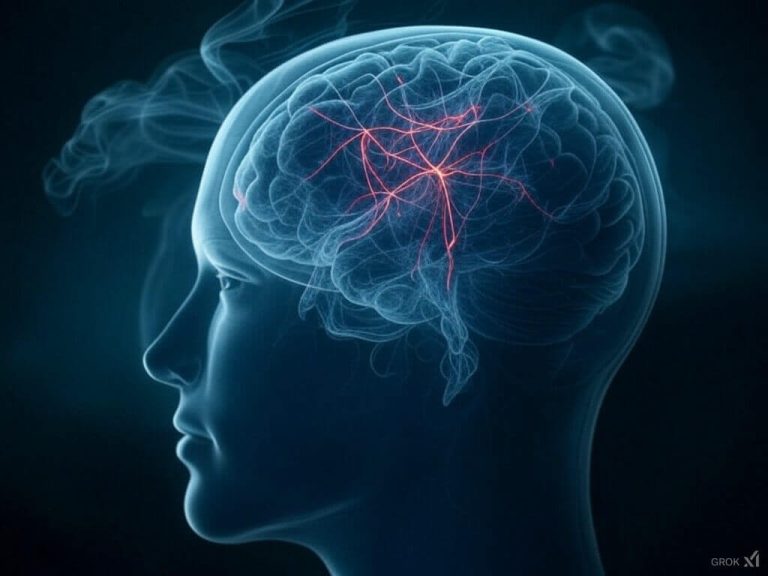ADHD, or Attention Deficit Hyperactivity Disorder, is like having a brain that’s caffeinated all the time, where your thoughts are bouncing around like an over-enthusiastic puppy on their first trip outside.
Although rates vary across the world, an estimated 8.4% of children and 4.4% of adults have ADHD, making it one of the most common childhood disorders and subject to much scientific inquiry.
ADHD is one of the more difficult disorders to clamp down on, as the boundary between those with ADHD and those who simply struggle to focus can vary widely.
As a result, many children (and adults) continue with their struggles without being correctly diagnosed. Conversely, many children are diagnosed with ADHD when they simply lack focus and concentration, which, like all skills, require practice to improve.
This article aims to take a scientific approach to understanding the common symptoms of ADHD, and how you can recognize, in yourself and others, whether symptoms such as irritability, a lack of focus, and poor memory might warrant further exploration from a qualified medical professional.
What is ADHD?
Attention Deficit Hyperactivity Disorder (ADHD) is a neurodevelopmental disorder that affects both children and adults, often characterized by traits such as inattention, impulsivity, and hyperactivity that can interfere with an individual’s functioning and daily life.
Many confuse ADHD with Attention Deficit Disorder (ADD). While ADD was once a specific subclass of ADHD, ADD is now an outdated term in modern scientific and psychological literature, although some texts still use the terms synonymously.
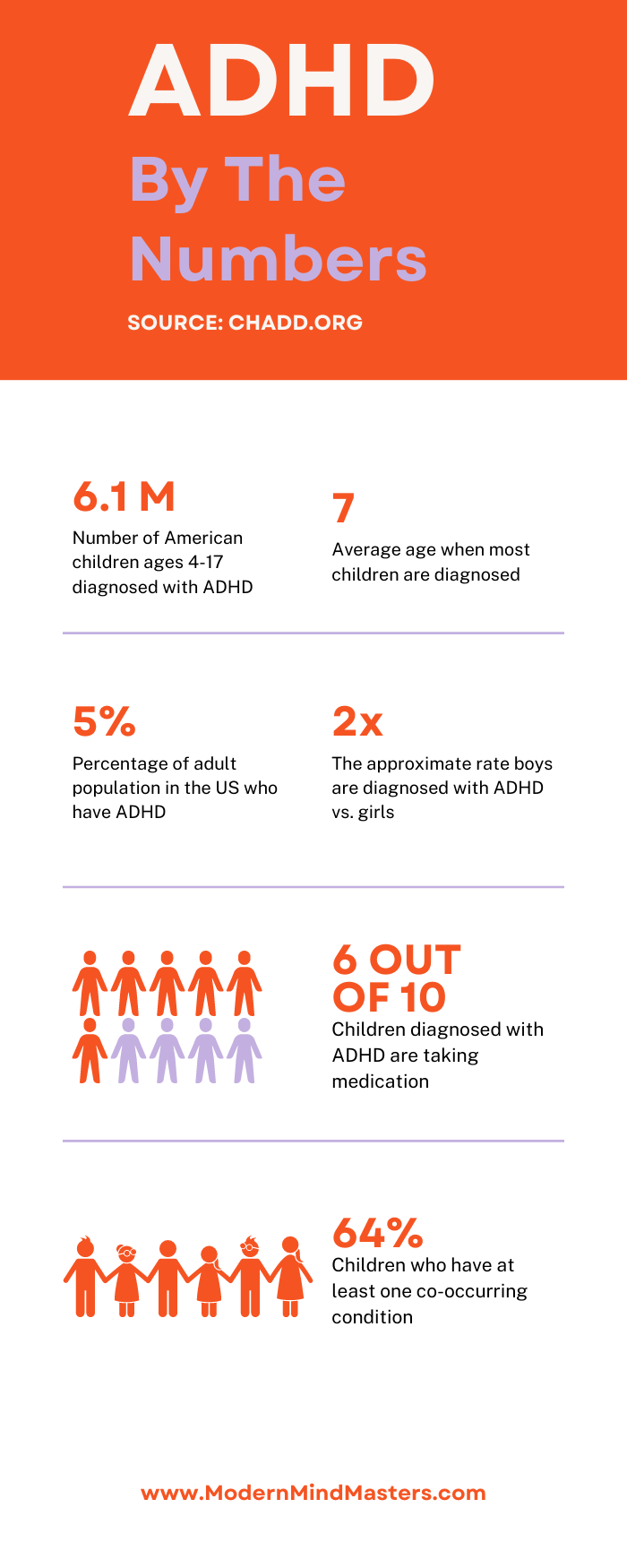
What Causes ADHD?
While ADHD is one of the most frequently researched and studied disorders, its symptoms and causes are so complex and varied that the exact neurological mechanisms underlying it are still not fully understood.
Neurological brain imaging techniques, however, have revealed circuits in the brain that fire differently from those without ADHD, specifically the Default Mode Network (DMN) and Task-Positive Networks (TPN).
Default Mode Networks (DMN) and Task-Positive Networks (TPN)
You can think of your brain’s DMN as the daydreaming network, active when you’re not focused on any particular task, such as when daydreaming or relaxing on the beach (it loves to wander off into its own little world).
While it may seem like the DMN is just there to distract you during important events, it actually serves some valuable purposes, such as supporting introspection and self-reflection.
When you’re not actively engaged in a specific task, the DMN kicks in and allows your mind to wander, explore memories, make connections, and even engage in creative thinking.
Task Positive Networks (TPN), on the other hand, are goal-oriented and engaged when focusing on tasks that require attention and concentration. You can think of it as a hyper-focused, get-it-done network.
In a non-ADHD brain, these two systems seesaw; when the DMN is active, the TPN quietens, and vice-versa. When meditating, for example, the DMN will fire up while the TPN disengages, allowing you to let go of any stress and anxiety and (hopefully) enter a state of relaxation.
Neural imagining of ADHD brains, however, shows that both of these systems fire at the same time. While we might think of those with ADHD, who suffer from symptoms such as a lack of focus and attention, as under-activating brains, they are actually overactivating. It is certainly not that those with ADHD are lazy; in fact, it is quite the opposite; there is too much neural engagement.
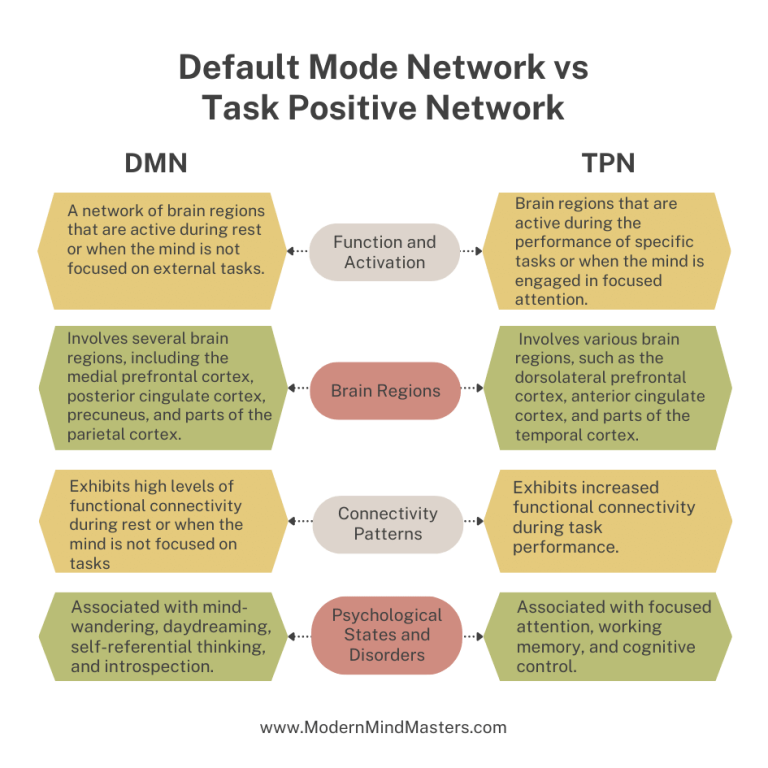
Low Dopamine Causes Dysfunction in Neural Circuitry
So why do these circuits tend to fire at the same time when they shouldn’t? Underlying this neural desynchronization is dopamine, a neurotransmitter (chemical messenger) that plays a crucial role in various physiological and cognitive functions such as motivation, reinforcement, and the experience of pleasure and reward.
When dopamine levels are too low in certain circuits in the brain, it leads to the unnecessary firing of neurons unrelated to the ones needed for the task you are trying to perform.
You can think of dopamine as a conductor, signaling to both the DMN and TPNs when to go loud and quiet, like an orchestra’s vocal and instrumental sections.
In those with ADHD, however, the conductor tells both to go loud simultaneously, making the music sound like quite a mess. While the individual parts of the brain (like the band) are playing everything correctly, together, they lack the synchronicity that makes an orchestra so wonderful.
Essentially, there is insufficient dopamine to manage each of the circuits correctly, and they tend to get lazy and confused and fire out of time (like a confused conductor waving his hands chaotically).
Symptoms of ADHD
By understanding the role of low dopamine levels on the two neural circuits responsible for causing ADHD, the symptoms will make much more sense. Here are nine of the most common symptoms of ADHD.
1) ADHD and Poor Attention/Focus
Perhaps the most common symptoms associated with ADHD are a poor attention span and an inability to focus.
Imbalances of neurotransmitters such as dopamine and norepinephrine, which play a crucial role in regulating attention, focus, and impulse control, are thought to be the driving cause.
Studies have found that individuals with ADHD exhibit weaker function and structure in the prefrontal cortex (PFC) circuits, particularly in the right hemisphere, circuits responsible for regulating emotion, behavior, and emotion and rely on optimal levels of certain neurotransmitters to function properly.
Seeing as dopamine is a large driving force behind the reward system, that is, it provides a significant amount of energy to overcome effort to achieve something, it is perhaps not surprising that those with low dopamine levels, such as individuals with ADHD, experience decreased motivation and difficulties in sustaining attention on tasks that do not provide immediate rewards.
2) High Levels of Impulsivity
Impulsivity, broadly defined as action without foresight, is a component of numerous psychiatric illnesses, such as ADHD, mania, and substance abuse.
This study explored the effects of ADHD on impulsivity and found that individuals with ADHD exhibit deficits in inhibitory control and show increased impulsivity in various tasks.
In terms of impulsive action, individuals with ADHD demonstrated slower response inhibition and higher rates of errors in specific tasks. Regarding impulsive choice, individuals with ADHD tended to prefer smaller immediate rewards over larger but delayed rewards in delay-discounting paradigms.
Similar to symptoms of poor attention and focus, the neural basis of impulsive behavior can be traced back to dysfunction within the prefrontal cortex, specifically the orbitofrontal cortex (OFC).
3) Irritable and Easily Annoyed
Irritability, whether measured as a continuous trait or as part of another mood disorder, is commonly associated with adolescent depression symptoms.
But this study also correlated irritability and depressive symptoms with ADHD, suggesting they can all interact together to worsen each other.
While irritability alone may not be a direct result of ADHD, research suggests that it can be a tell-tale sign of potential future depressive problems, especially when it persists over time.
The findings also suggested that clinicians should identify and monitor irritability in individuals with ADHD, particularly those who continue to experience irritability into adolescence. These individuals may be at higher risk for depression and should be considered potential targets for intervention and prevention of depression.
4) Challenges with Time Perception
A lesser-known but high-impact symptom of ADHD is challenges with the perception of time. Whether running late for a meeting or underestimating the time they have for an important deadline, gauging time can be a challenge for many.
Those with ADHD might also have trouble organizing their day to meet deadlines, even if it’s as simple as finishing a task before breaking for lunch.
Since ADHD affects the prefrontal cortex, and the prefrontal cortex controls many of our executive functions, such as organization, self-regulation, and time management, difficulties in this area can make it challenging for individuals with ADHD to accurately gauge the passage of time.
Combine this with other symptoms of ADHD, such as impulsivity and a lack of focus, and it is no wonder those with ADHD struggle to manage their priorities and remain on schedule.
There is one rule to the exception, however. Given a task or deadline that is very important, where the threat of failure acts as an intense emotional motivator, individuals with ADHD can perceive time incredibly well. Again, this is only if the consequences of not completing the task are severe enough to induce a motivation to complete it.
This is why those with ADHD perform well under pressure. When a deadline looms, they can hyper-focus on getting it done, not because they thoroughly enjoy it, but because the threat of the deadline is so strong they are engaged wholly until it is complete and out of their mind.
5) Poor Spatial Organization Skills
Those with ADHD often have subpar spatial organization skills, leading to many thinking they are lazy with their cleanliness or simply unorganized.
Many use the “pile system” to organize their things, such as stationary on a desk piled up with no apparent logic or cutlery in the kitchen placed in areas that make no sense to others.
But this pile system works in a way that makes sense only to them. They might not be objectively logical, but to them, it works, and if anyone moves anything they become irritated and frustrated.
6) Working Memory
Although we might all wish for a better memory, those with ADHD particularly struggle with working memory, the ability to keep specific information online and to continuously recycle it to quickly recall it within a short period (typically a few minutes).
Say you need to use the washroom in a Starbucks, and the barista tells you the passcode is 1357. While those without ADHD might have to repeat it a few times to be able to recall it for a few minutes, those with ADHD will struggle to remember it almost immediately.
This article found that working memory deficits occurred in approximately 80–85% of children with ADHD when evaluated with cognitive tasks. That is a huge impact and is one of the most impactful symptoms seen by those with ADHD.
Interestingly, those with ADHD have been shown to have a terrific memory outside of working memory, such as past events that happened decades ago, although various studies have proved to have mixed results.
This study, for example, found that adults with ADHD performed significantly worse than controls on verbal but not on visual long-term memory and memory acquisition subtests, suggesting that they find certain sensory information more difficult to recall than others.
7) ADHD Rejection Sensitive Dysphoria (RSD)
Rejection sucks for everyone, no matter how capable a person may be. But some people are better at accepting it than others.
JK Rowling, for example, faced numerous rejections from publishers before finally finding one willing to take a chance on her magical character, Harry Potter. Walt Disney, one of the most famous cartoonists of all time, was fired from a newspaper for “lack of imagination” and was turned down by several banks when seeking funding for Disneyland.
For those with ADHD, however, even slight rejections can be crippling. Rejection-sensitive dysphoria (RSD) is a term that is often associated with ADHD, where any perceived rejection, criticism, or failure is met with an intense emotional response.
Individuals with ADHD who experience RSD may have a heightened sensitivity to rejection or the possibility of rejection, leading to intense feelings of sadness, hurt, shame, or anger.
The exact neurobiological mechanisms underlying RSD in ADHD are not well understood. However, it is believed to be related to a combination of emotional dysregulation and executive functioning deficits common to most other symptoms.
With a fear of rejection comes a fear of failure, where those with ADHD may have a fear of failure so great that even its anticipation is enough to cause crippling anxiety.
To make matters worse, such reactions tend to compound over time, negatively reinforcing these habits in the brain and making individuals even more susceptible to experiencing RSD in the future.
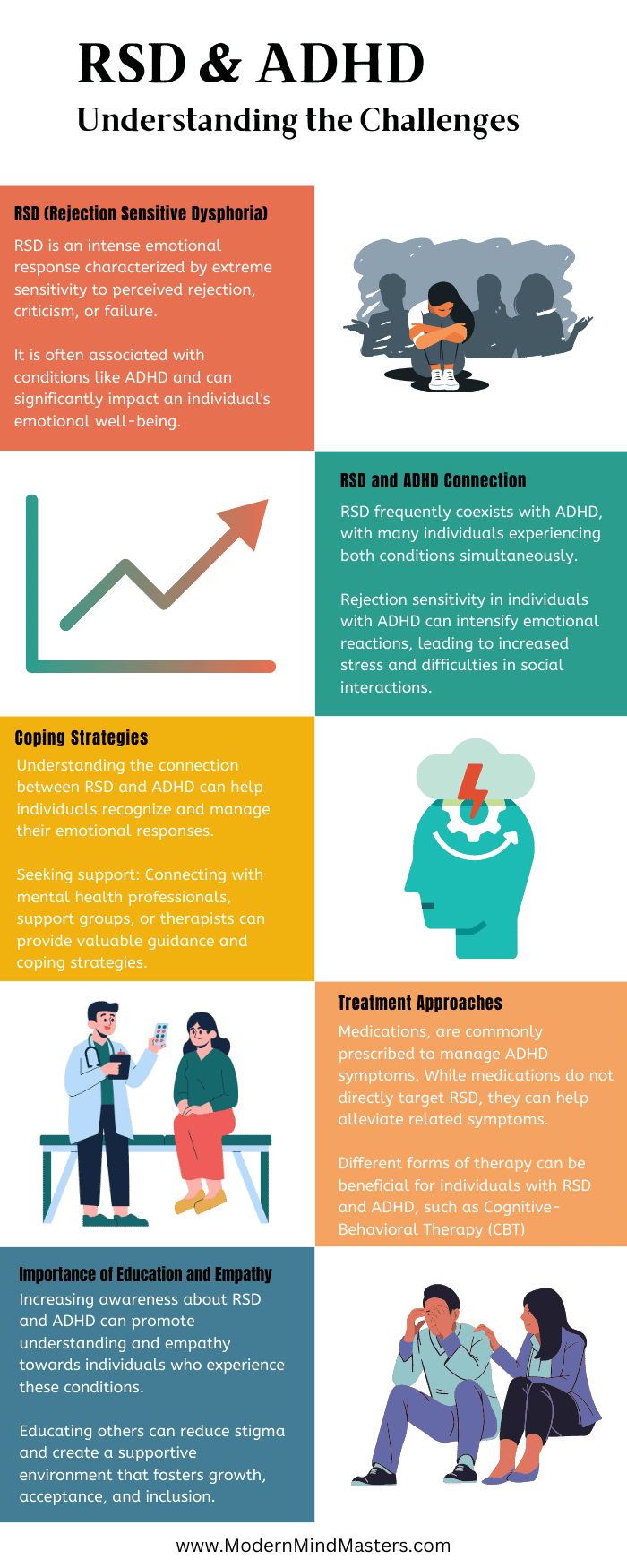
8) Hyperfocus & Hyperfixation
Hyperfocus is a term commonly associated with ADHD, describing the state in which individuals with ADHD become deeply engrossed in a particular task or activity, often characterized by high productivity, intense concentration, and a sense of losing track of time.
The DSM-V, the diagnostic manual for psychiatric disorders, does not explicitly refer to hyperfocus as a symptom of ADHD, but references to it as a symptom are pervasive in academic literature.
We all get fixated on certain tasks from time to time, whether playing a new video game or buying a new car. But those with ADHD take these fixations to a whole new level, sometimes becoming obsessed to the point of addiction.
One study used EEG measurements while participants played a video game and found that patients with ADHD showed distinct patterns of brain activity different from control groups without ADHD.
Hyperfixation, on the other hand, is often associated with neurodivergent conditions such as autism spectrum disorder (ASD), referring to a strong and intense preoccupation or fixation on specific subjects, topics, or activities.
Unlike hyperfocus, hyperfixation may not necessarily involve enhanced productivity or the ability to sustain attention in a task-oriented manner. Instead, it is characterized by a deep and consuming interest that can persist for extended periods.
9) ADHD Paralysis
ADHD paralysis, also known as “analysis paralysis” or “decision paralysis,” is a phenomenon where some individuals with ADHD may become overwhelmed or unable to take action due to difficulties with decision-making, prioritization, and initiating tasks, leading to a sense of being “stuck”, despite having a desire or intention to accomplish something.
The neurobiological basis of ADHD paralysis is not clearly understood but is thought to be related to the underlying executive functioning deficits associated with low dopamine and a dysregulation of the DMN and TPN, where executive functions such as planning, organizing, and initiation are thus impaired.
Emotional factors can also play a role in ADHD paralysis, where frustration and anxiety can arise from feeling unable to make progress or complete tasks.
To control ADHD paralysis, common management strategies can be implemented, such as breaking tasks into smaller, more manageable steps or creating to-do lists.
While ADHD paralysis is a common experience for individuals with ADHD, it is a symptom that all people struggle with periodically. With appropriate strategies and support, it is possible to overcome it and regain a sense of productivity and accomplishment.
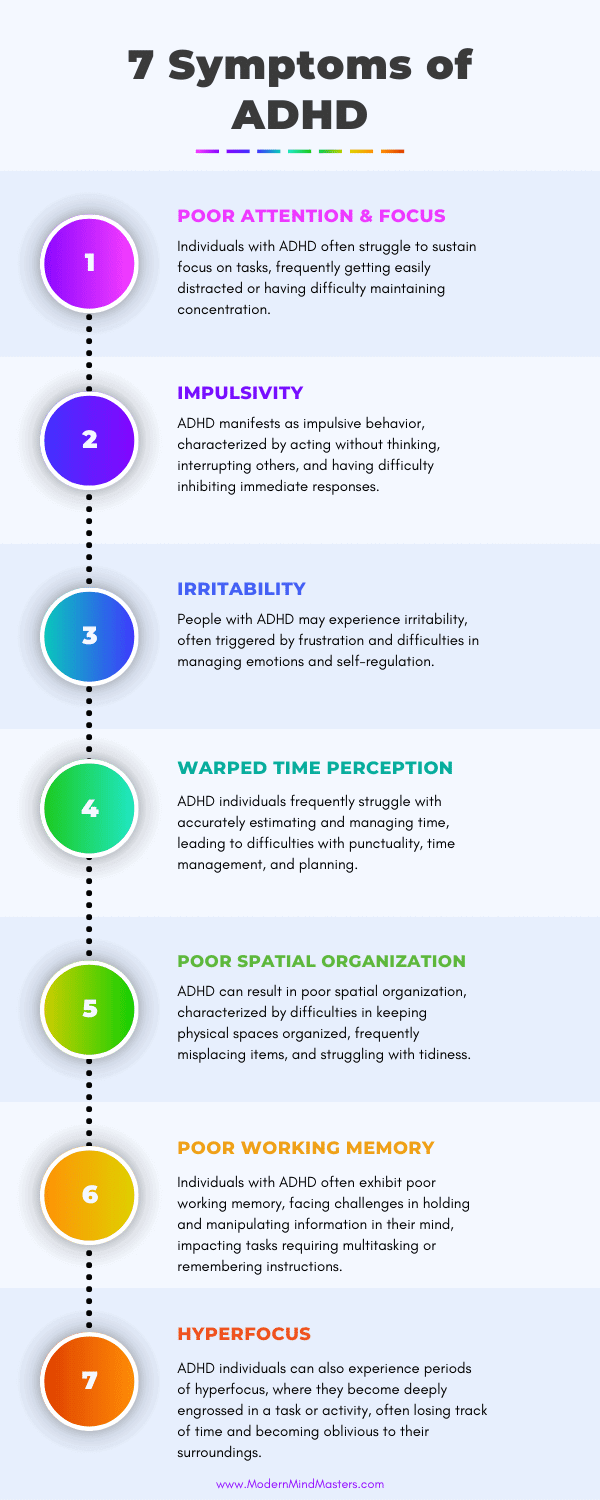
Conclusion
ADHD is a neurodevelopmental disorder that affects both children and adults, characterized by symptoms such as inattention, impulsivity, and hyperactivity.
The complex nature of ADHD and its numerous and varied symptoms makes it challenging to diagnose accurately, and many individuals may go undiagnosed or misdiagnosed.
The symptoms outlined in this article, such as lacking attention, high levels of impulsivity, irritability, poor working memory, and an intense fear of rejection, have underlying neurobiological reasonings; low levels of neurotransmitters such as dopamine and norepinephrine cause dysregulation in neural circuits such as the default mode network and task positive networks.
Understanding the underlying neurobiology of ADHD symptoms can help individuals and their loved ones develop strategies to manage and cope with the challenges posed by the disorder. While ADHD can present significant difficulties, it’s important to recognize that individuals with ADHD also possess unique strengths and talents.
Overall, recognizing and addressing the symptoms of ADHD can lead to improved outcomes and a better understanding of how to support individuals with the condition. Seeking guidance from healthcare professionals can provide further insights, diagnosis, and appropriate interventions tailored to each individual’s needs.
So let’s embrace our unique symphony of chaos and creativity, knowing that with the right understanding and support, we can compose our own masterpiece.
FAQs
What are the most common symptoms of ADHD?
The most common ADHD symptoms include poor attention, distractibility, impulsivity, irritability, challenges with time management, weak working memory, emotional sensitivity, hyperfocus, and difficulty starting tasks. Symptoms vary widely, so severity and combinations differ between individuals.
How do ADHD symptoms affect the brain?
ADHD symptoms stem from differences in brain networks like the Default Mode Network (DMN) and Task-Positive Network (TPN), which tend to activate simultaneously. Low dopamine levels make it harder to regulate attention, motivation, and impulse control, leading to the symptoms seen in ADHD.
How do I know if my symptoms might be ADHD?
If you consistently struggle with focus, impulsivity, time management, emotional sensitivity, or working memory—and these issues affect daily life—it may be worth speaking with a qualified medical professional. A diagnosis relies on patterns lasting at least six months, not occasional distraction.



